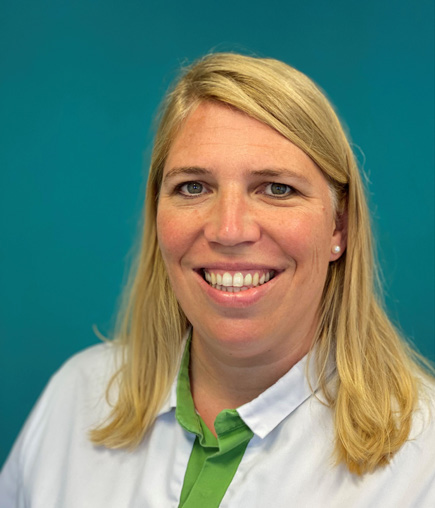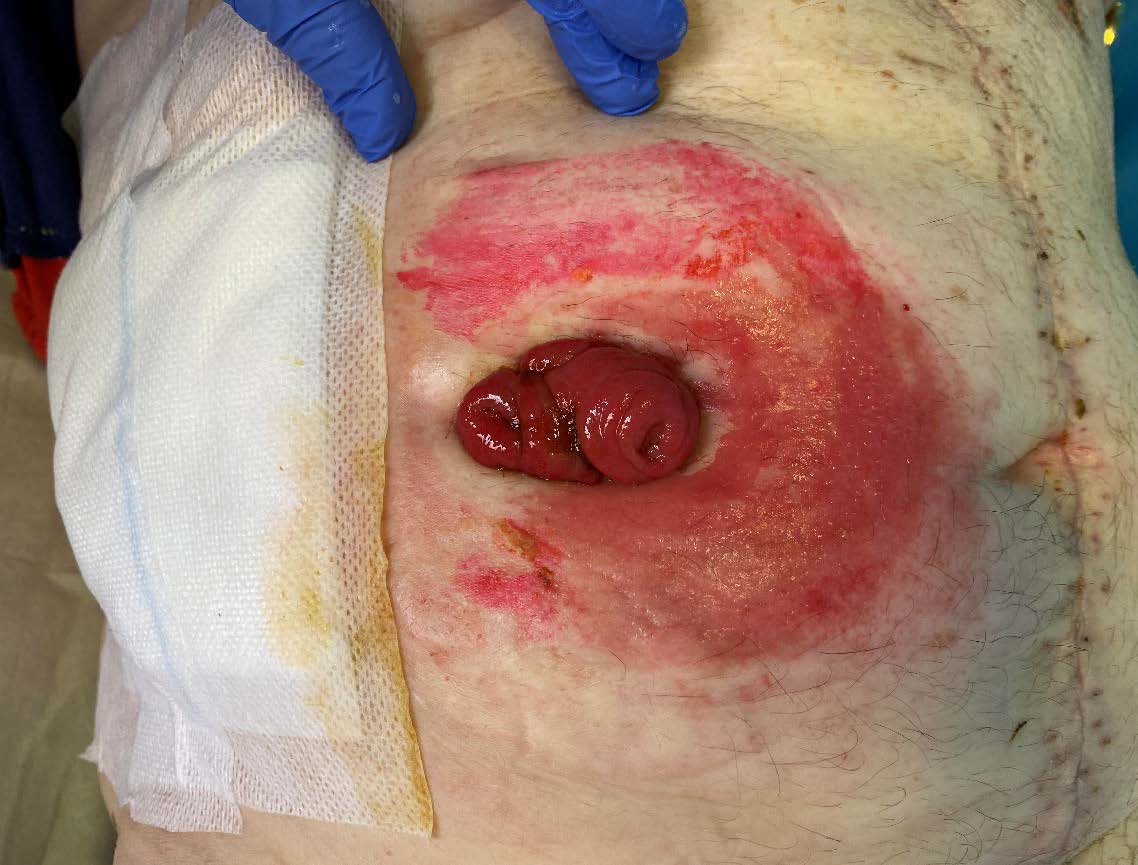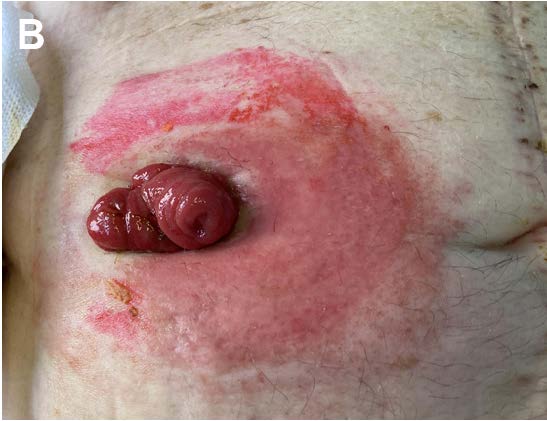
Valerie Hanssens has been a nurse at the University Hospital of Brussels since 2002 where she started working in abdominal and plastic surgery for the first 8 years of her career. During that time, Valerie received postgraduate certification in wound care and in ostomy, incontinence, and fistula care. In preparation for new career opportunities she completed her Master’s in Nursing at Vrije Universiteit in Brussels. She is currently completing her PhD in pressure ulcer prevention at the same university. Since 2008 Valerie has worked as a nurse specialist in wound care and is an active board member of the Belgian Ostomy Nursing Association and the Belgian Wound Care Association. Ms. Hanssens is a paid consultant for 3M.
Hanssens_Current-Dialogues-in-Wound-Management_2021_Article-1
INTRODUCTION
Peristomal dermatitis refers to skin damage where there is a clear interaction between the skin and the stoma effluent, fluids, secretions, and/or output. Peristomal dermatitis results in inflammation or erosion of the skin due to moisture from fecal, urinary, and chemical irritants beginning at the mucocutaneous junction, which can spread outwards to affect the surrounding skin. More than 50% of individuals with ostomies experience leakage.1 Patients living with an ileostomy are more likely to experience peristomal moisture-associated skin damage (MASD) than are patients living with a colostomy.2-4
This article reviews a case of MASD in a patient at University Hospital of Brussels in early 2021. The patient had undergone a rectosigmoidectomy for a locally advanced adenocarcinoma in the sigmoid colon with suspected bladder invasion. Due to dehiscence of the anastomosis, the patient underwent a laparotomy with cleansing and rinsing of the abdomen and a loop ileostomy. After 10 days, the patient was eligible for discharge.
Despite receiving ostomy education from the ostomy care nurse, the patient was not comfortable with changing his appliances on his own. He was discharged from the hospital with a two-piece flat appliance with ileostomy bag. The home care nurse changed the appliance 3 times per week and the patient changed and emptied the ileostomy bag himself.
In early May 2021, visible erosion with total skin loss due to leakage of the ileostomy output across almost the entire peristomal area was observed (Figure 1).

The red discoloration was due to the use of a topical eosin stain which was used with the goal of keeping the peristomal skin dry in the home care setting. The patient described the erosion as extremely painful with a burning sensation. As a result of several leakages, the patient was reluctant to leave his home and used adhesive strips to provide extra fixation of the plate to try to reduce leakage. As a result of these adhesives, the patient suffered from peristomal medical adhesive-related skin injury (PMARSI).
In order to address the peristomal skin concerns, 3M™ Cavilon™ Advanced Skin Protectant was added to the patient’s care plan. Cavilon Advanced Skin Protectant was applied to the peristomal skin (Figure 2). While the initial application can be a little uncomfortable for the patient as a result of erosions due to peristomal skin damage, the advantage of using Cavilon Advanced Skin Protectant is its rapid onset of action in protecting and managing wet and damaged skin. It is important to let Cavilon Advanced Skin Protectant dry completely before placing the patient’s ostomy appliance.


In addition to the addition of Cavilon Advanced Skin Protectant, the patient’s appliance was changed from a flat plate to a convex one which provided extra fixation. Ostomy paste was used and applied to the plate to reduce the risk of leakage. The plate was clipped 2 mm wider than the ostomy, thereby allowing the paste to form a dam against leakage. This reduced the need for the patient to manage ostomy leakage and ultimately reduced the likelihood of PMARSI.
After one application of Cavilon Advanced Skin Protectant, marked improvement of the peristomal MASD was observed along with the complete healing of PMARSI (Figure 3).

CONCLUSION
Patients living with an ileostomy have a high risk of developing peristomal MASD due to the high rates of ostomy site leakage.1-4 The resulting peristomal dermatitis leads to inflammation or erosion at the site of leakage which can spread outwards to affect the surrounding skin. A single case was presented showing a typical case of MASD of the peristomal skin at our institution. In this patient, the use of ostomy paste, changing the ostomy appliance to one that provided extra fixation, and the application of Cavilon Advanced Skin Protectant helped manage the peristomal skin. However, Cavilon Advanced Skin Protectant use should also be considered before ostomy site leakage occurs to protect the peristomal skin and potentially reduce the risk for MASD development.
References
References
- Woo KY, Beeckman D, Chakravarthy D. Management of Moisture-Associated Skin Damage: A Scoping Review. Adv Skin Wound Care. 2017;30(11):494-501. doi:10.1097/01.ASW.0000525627.54569.da.
- Colwell JC, McNichol L, Boarini J. North America Wound, Ostomy, and Continence and Enterostomal Therapy Nurses Current Ostomy Care Practice Related to Peristomal Skin Issues. J Wound Ostomy Continence Nurs. 2017;44(3):257-261. doi:10.1097/WON.0000000000000324
- Nagano M, Ogata Y, Ikeda M, Tsukada K, Tokunaga K, Iida S. Peristomal Moisture-Associated Skin Damage and Independence in Pouching System Changes in Persons With New Fecal Ostomies. J Wound Ostomy Continence Nurs. 2019;46(2):137-142. doi:10.1097/WON.0000000000000491
- Fletcher J, Beeckman D, Boyles A, Fumarola S, Boyles A, Kottner J, McNichol L, Moore Z, Sarkar N, Stenius M, Voegeli D. International Best Practice Recommendations: Prevention and management of moisture-associated skin damage (MASD). Wounds Int. 6 October 2020. https://www.woundsinternational.com/resources/details/best-practice-recommendations-prevention-and-management-moisture-associated-skin-damage-masd
Patient data and images courtesy of Valerie Hanssens, Clinical Nurse Specialist, Wound Care, University Hospital of Brussels.
As with any case study, the results and outcomes should not be interpreted as a guarantee for warranty of similar results. Individual results may vary depending on the patient’s circumstances and condition.
NOTE: Specific indications, contraindications, warnings, precautions and safety information exist for these products and therapies, some of which may be Rx only. Please consult a clinician and product instructions for use prior to application.
© 2022 3M. All rights reserved. 3M and the other marks shown are marks and/or registered marks. Unauthorized use prohibited. Used under license in Canada.

